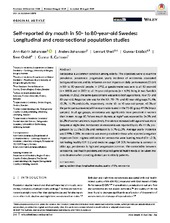| dc.contributor.author | Johansson, Ann Katrin | en_US |
| dc.contributor.author | Johansson, Anders | en_US |
| dc.contributor.author | Unell, Lennart | en_US |
| dc.contributor.author | Ekbäck, Gunnar | en_US |
| dc.contributor.author | Ordell, Sven | en_US |
| dc.contributor.author | Carlsson, Gunnar E | en_US |
| dc.date.accessioned | 2020-06-19T14:27:38Z | |
| dc.date.available | 2020-06-19T14:27:38Z | |
| dc.date.issued | 2019-08-23 | |
| dc.Published | Johansson AK, Johansson AA, Unell L, Ekbäck G, Ordell S, Carlsson GE. Self-reported dry mouth in 50- to 80-year-old Swedes: Longitudinal and cross-sectional population studies. Journal of Oral Rehabilitation. 2020;47:246-254 | eng |
| dc.identifier.issn | 0305-182X | |
| dc.identifier.uri | https://hdl.handle.net/1956/22780 | |
| dc.description.abstract | Xerostomia is a common condition among elderly. The objectives were to examine prevalence, persistence, progression, yearly incidence of xerostomia, associated background factors and its influence on oral impacts on daily performances (OIDP) in 50‐ to 80‐year‐old people. In 1992, a questionnaire was sent to all 50‐year‐old (n = 8888) and in 2007 to all 75‐year‐old persons (n = 5195) living in two Swedish counties. In 2012, the same questionnaire was sent to both age cohorts, now 70‐ and 80‐year‐old. Response rate was for the 50‐, 70‐ 75‐ and 80‐year‐old groups 71.4%, 72.2%, 71.9% and 66.4%, respectively. In the 50‐ to 70‐year‐old sample, 40.3% of the participants answered all five examinations and in the 75‐80 group 49.5% (intact samples). In all age groups, xerostomia was significantly more prevalent in women than in men. At age 80, “often mouth dryness at night” was reported by 24.3% and 16.2% of women and men, respectively. Prevalence increased with age and was more frequent at night‐time. Persistence of xerostomia was reported by 61.4%‐77.5%, progression by 11.5%‐33.0% and remission by 5.7%‐11.3%. Average yearly incidence was 0.99%‐3.28%. Xerostomia was more prevalent in those who reported a negative impact on OIDP. Highest odd ratios for xerostomia were burning mouth (OR 12.0), not feeling healthy (OR 5.1) and medicine usage (OR 3.9). Xerostomia is common in older age, persistence is high and progression common. The comorbidity between xerostomia, oral health problems and impaired general health needs to be taken into consideration when providing dental care to elderly patients. | en_US |
| dc.language.iso | eng | eng |
| dc.publisher | Wiley | eng |
| dc.rights | Attribution-NonCommercial-NoDerivs CC BY-NC-ND | eng |
| dc.rights.uri | http://creativecommons.org/licenses/by-nc-nd/4.0/ | eng |
| dc.subject | ageing | eng |
| dc.subject | Epidemiology | eng |
| dc.subject | longitudinal studies | eng |
| dc.subject | Quality of life | eng |
| dc.subject | xerostomia | eng |
| dc.title | Self-reported dry mouth in 50- to 80-year-old Swedes: Longitudinal and cross-sectional population studies | en_US |
| dc.type | Peer reviewed | |
| dc.type | Journal article | |
| dc.date.updated | 2020-01-30T07:39:18Z | |
| dc.description.version | publishedVersion | en_US |
| dc.rights.holder | Copyright 2019 The Author(s) | |
| dc.identifier.doi | https://doi.org/10.1111/joor.12878 | |
| dc.identifier.cristin | 1753358 | |
| dc.source.journal | Journal of Oral Rehabilitation | |
| dc.source.pagenumber | 246-254 | |
| dc.identifier.citation | Journal of Oral Rehabilitation. 2020, 47 (2), 246-254. | |
| dc.source.volume | 47 | |
| dc.source.issue | 2 | |

